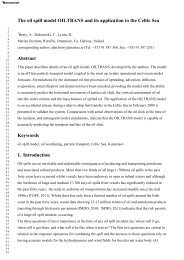Marine Industries Global Market Analysis - Marine Institute
Marine Industries Global Market Analysis - Marine Institute
Marine Industries Global Market Analysis - Marine Institute
Create successful ePaper yourself
Turn your PDF publications into a flip-book with our unique Google optimized e-Paper software.
104 MARINE INDUSTRIES GLOBAL MARKET ANALYSIS<br />
‘Tidal’ is electricity produced as a direct consequence of the large-scale movement of<br />
bodies of water due to the ebb and flow of the tides.<br />
‘Tidal Current Stream’ is electricity produced through the regular flow of currents.<br />
Whilst tidal action may affect the direction and intensity of a current stream its<br />
motion is not directly dependent upon it. Operating examples include <strong>Marine</strong><br />
Current Turbine’s ‘seaflow’ project off the UK, which was the first tidal current stream<br />
turbine to come online.<br />
Table 18.2: Electricity Generation Costs<br />
Energy Type<br />
€Cents/kWh<br />
Onshore Wind 5.3<br />
Offshore Wind 7.9<br />
Wave/Tidal 9.5<br />
Nuclear Fission 3.3<br />
Coal 3.6 – 4.6<br />
Gas 3.2 – 4.5<br />
Source: The Royal Academy of Engineers<br />
March 2004<br />
18.7 THE LONG-TERM – 2010 ONWARDS<br />
The major challenge faced by offshore renewable energy is in reducing its costs to be<br />
comparable with ‘conventional’ power generation from gas and coal.<br />
The costs in table 18.2 include:<br />
• Capital cost, fuel and operational cost<br />
• Transmission and storage of gas.<br />
Standby generation is also needed for onshore/offshore wind for periods of low wind<br />
and if included this would add approx 1.7 cents/kWh.<br />
Other studies by OXERA, for the UK government’s Renewables Innovation Review,<br />
show that prices for onshore wind could drop to 3.9 cents/kWh by 2010.<br />
Most of the new power generation capacity installed in Western Europe and many<br />
other countries in the past 20 years is fuelled by gas. However, the UK (and the US)<br />
are now facing gas supply shortages and although new foreign supplies can be sourced<br />
these will be at a higher cost.<br />
In addition, by the middle of the next decade it is likely that shortages of oil, leading<br />
to real price increases, will boost demand for gas and result in further gas price<br />
increases.We believe that the overall result of this will be to improve the competitive<br />
position of renewable energy.<br />
There is also potential for the drive for development of renewable energy resources to<br />
change progressively from green politics to security of supply.

















